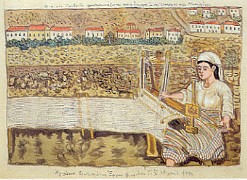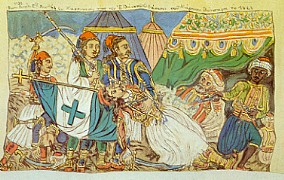|
 More often
he would wear a kilt and carry an old curved
yataghan at his side or he would paint murals of
the Greek War of Independence. It was thus he
appeased his passion.
More often
he would wear a kilt and carry an old curved
yataghan at his side or he would paint murals of
the Greek War of Independence. It was thus he
appeased his passion.
He left for Pelion on the mainland where he found
work as a shepherd, and there, whenever he came
across a mill or a coffeehouse with plastered
walls, he would cover them with murals. He wore
his kilts all the time there, even though the
local people wore breeches and thus he earned
himself the nickname Tsolias. On his return from
Volos he threw away his shepherds crook and earned
himself a living any way he could, begging for a
piece of canvas or a white wall where he could
paint his pictures. He didn't ask for money; only
a plate of food and a supply of water-colors. His
passion was to paint heroic themes, events in the
life of Ali Pasha, and hunting scenes. When he was
dead the critics of Athens and Paris proclaimed
him a great painter and his pictures became
extremely valuable".
From the book
Vasilis Arvanitis by Stratis Myrivilis written
in 1934.
 No other folk painter or even perhaps
classical painter has been honored since his
death as much as the day-dreamer Theophilos.
Among the other figures of Greek art and
intellect who were at the August 1965 opening
of his museum was the Nobel prize-winning poet
George Seferis.
No other folk painter or even perhaps
classical painter has been honored since his
death as much as the day-dreamer Theophilos.
Among the other figures of Greek art and
intellect who were at the August 1965 opening
of his museum was the Nobel prize-winning poet
George Seferis.
Be sure to visit the Theophilos Museum in
Mytilini. Don't forget to see the hollowed out
tree Theophilos lived in at the spring of
Karini on the road to Agiassos. Keep your eyes
open and you may discover a Theophilos on the
wall of some cafeneon in a remote village
somewhere on Lesvos. |